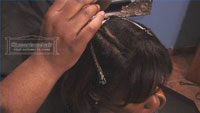


CopyFrom: Author:Alex Y DateTime:2015-01-31 Hits:0
Hair is sewn onto a cornrowed base to create no-fuss weave hairstyles.For those looking for a stylish look with minimal upkeep, a weave hairstyle may be an option to consider. While glue-in hair weave methods can damage hair, sew-in hair weave styles are much gentler. A successful sew-in hair weave style requires a cornrowed base. The ideal cornrow design and styling technique vary depending on hair length and desired style. When done correctly, cornrow can promote hair retention and help minimize breakage and damage.

Circular Cornrowing:
Some cornrowing technique involves the use of a continual cornrow that covers the head in a circular pattern, terminating at the top of the head. This method is best for advanced cornrowers, as it is somewhat complicated. It has the advantage over the simple vertical cornrowing technique in ensuring a smoother hair weave finished. For those with extremely long hair, however, this technique produces the opposite result. The end of the cornrow will be too long to smoothly tuck and thus, when hair weave is sewn on, the top of the hair weave style may be bumpy sometimes.
Cornrowing techniques that involve leaving sections of hair exposed produce the most realistic hair weave styles. Leaving a small section of the front of the hair unbraided makes it possible to make a natural bang that blends with the weave hair. Cornrow the hair straight back as in the typical vertical cornrowing technique, except for the hair in the front, which should be sectioned off. After the rest of the hair is cornrowed and the hair weave is attached, the hair in the front can be flat-ironed and combed to blend in with the hair weave.
Cornrowing for Blending:
Exposed outer edges also create more natural hair weave styles. Leaving the outer edges unbraided allows for high ponytails, as the natural hair is able to cover the tracks from the hair weave. This is an advantage over typical cornrowing techniques, which only allow for low ponytails or buns. For the most natural look, it is important that the color and texture of the weave hair match that of the natural hair. As with all cornrowing techniques, avoid braiding hair too tightly to prevent traction alopecia at front.